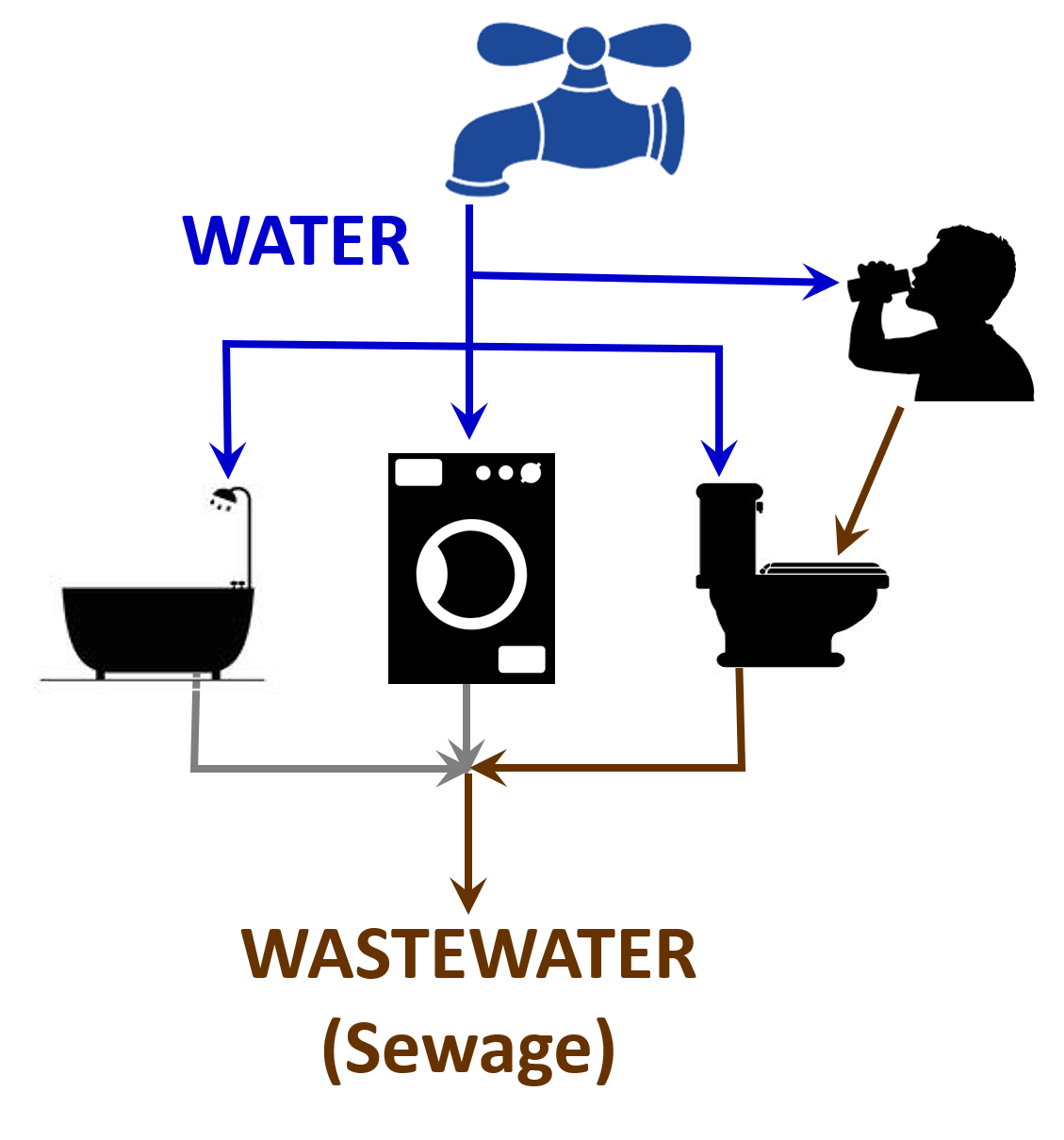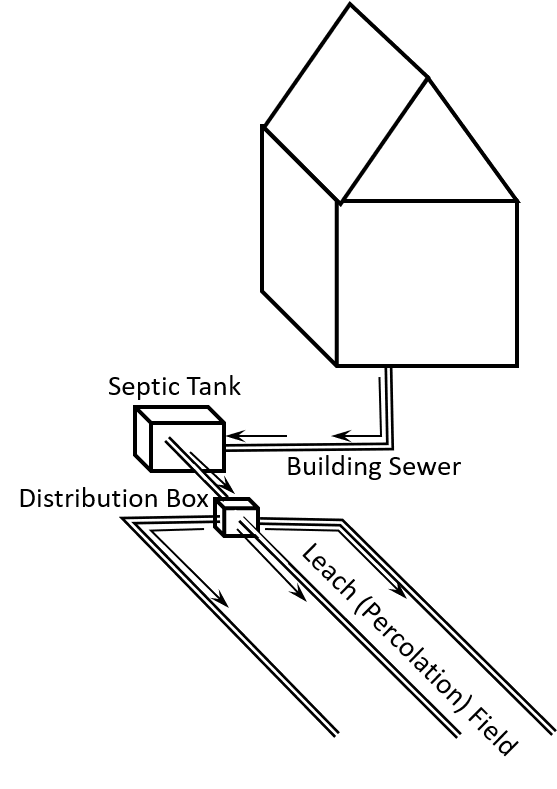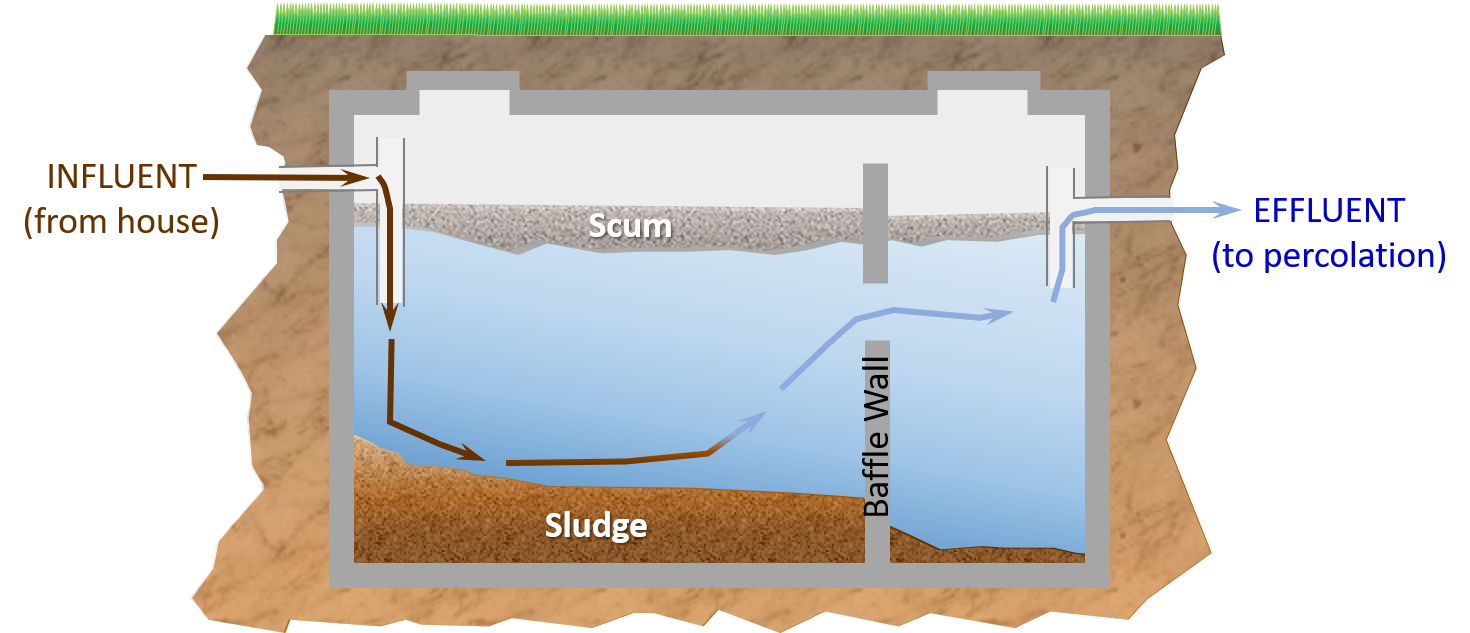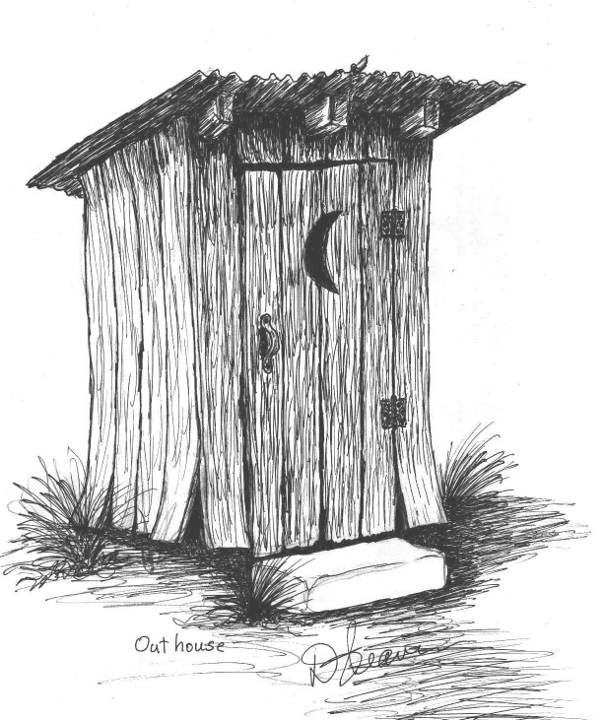


Ask an Engineer Why and How; Installment 2, What Happens After I Flush?; Number 1, Septic Tanks and Outhouses
Friday, February 1, 2019Ask an Engineer Why and How
Installment 2: What Happens After I Flush?; Number 1, Septic Tanks and Outhouses;
Anyone who’s ever owned a dog has probably, unfortunately, been an eyewitness to the answer to this question. Poo is food. So that’s your answer to “What happens after I flush?”, but let me step you through the processes.
1. Water Transformed to Wastewater
Our homes have water distribution plumbing that has WATER in it.
We use that WATER to drink, wash, and flush and almost all of it ends up in our homes’ drain plumbing at which point it becomes WASTEWATER or sewage.
In the United States, what most commonly happens to that wastewater is that is treated either onsite for an individual producer, or offsite (centralized) from where it originates for multiple producers of sewage, and after treatment it is discharged to the environment. For this edition, Number 1, I’m going to give you a little information about what is currently the most common type of onsite wastewater treatment, and one from the past (though we still use a form of them on camping trips in Northern Minnesota).
Here's a schematic of a typical septic system:

2. On-Site Wastewater Treatment, Septic Tanks
Although a significant portion of my life has been spent designing and operating wastewater treatment plants, every home that I’ve owned has had a septic tank. A septic system has three main components,
i. The drain, or sewer (or any number of names) which is the main 6” pipe (some older homes have 4” or 3” drain pipes) that collects the sewage from the point of generation (typically a home) and discharges it to the septic tank for treatment;
ii. The septic tank, which is usually completely underground, though newer tanks may have above ground access ports or vents;
iii. The percolation field, leach field, or tile field (again, a lot of different names for the same thing) which is a lattice of perforated pipes that allow the treated wastewater from the septic tank (effluent, septage) to soak into the ground. Usually the pipes are placed into a sand or gravel trench, and if the natural soil is impermeable (like a clay), or close to bedrock, or has a high groundwater elevation, or is in too small an area we build a mound of sand to discharge the effluent into. The effluent spreads-out through the sand over a large area and can then soak into the ground slowly, be absorbed by plants, and evaporate both directly and through the plants (transpiration).
The real work happens in the septic tank, and it has some critical characteristics:
i. It’s big enough that it takes a few days for the wastewater to flow through it.
ii. We don’t want it to get too hot in the summer, so we bury it.
iii. We don’t want it to get too cold in the winter, so we bury it.
iv. We don’t want much oxygen in it, so it has a solid lid. It also smells (to most people) which is another reason why we put a lid on it. One of my favorite lines that I learned years ago when I encounter a really odiferous sewer is to ask,
“Do you smell THAT?”
“Smells like money.”
Gotta have a “sense” of humor when you work around “scents”. (I’ve got a million of them…)
v. The sewage in the tank is an environmental contaminant subject to contact and transport by vectors (flies, mice, rats…) that can spread disease. This is arguably the most important reason why we put a lid on it.
Although there are many different designs, a basic septic tank looks like this:
Wastewater from the home flows into the first section of the tank. Chunky solids sink to the bottom where bacteria eat the carbon in the sludge and reproduce, are themselves eaten by other types of bacteria that also reproduce and are eaten, and this keeps going on as long as we keep adding food (wastewater) to the system.
Things that float stay on top of the tank and form a scum layer. To this scum is added dead bacteria that float up and some nibbling on the bottom of the scum occurs from bacteria that like this type of food. However, scum tends to build-up faster than it is removed by these bacteria, so a good rule of thumb is that if it floats (grease is an example), don’t flush it.
Between the sludge and the scum is clear liquid that includes suspended bacteria food (use your imagination). The bacteria that eat this waste, reproduce, die, sink, and are eaten in the sludge layer – some die and float. So essentially what is happening in the active portion of the septic tank is a lot of eating, reproducing and dying. The official term for this is “life”, which is why we call septic tanks a “biological process” (an important takeaway for understanding this and future blogs on this topic).
A baffle wall keeps most of the scum and sludge in the first section of the tank, but allows for a final settling and floating before the treated wastewater (effluent or septage) leaves the septic tank. This settling and floating we call a “physical process” because it occurs independent of the biological processes in the first section of the tank.
This effluent is NOT clean water. Although the water is cleaner (and clearer) than when it was flushed, it will destroy any stream or pond that it gets into, and can make you sick. The septage has little to no oxygen in it, so when it gets into a surface water it takes all of the oxygen away and kills the organisms that were living in the water. Also, the septage has a lot of food left in it, so microorganisms in the water aggressively start eating it and as they reproduce they use-up all of the oxygen in the water killing themselves and everything else. The amount of oxygen that these microorganisms use eating the waste is called the Biological Oxygen Demand (BOD) of the liquid.
The reason that septage can make you sick is that there can be bacteria, viruses, protozoa, spores, fungi… that were in the influent wastewater (your poop), but were not completely destroyed in the septic tank. Because a septic tank employs only one treatment stage (and no disinfection) we only get one shot at removing the nasty critters and a few can sneak by.
So, we encourage the treated septage to sink into the ground (percolate) where people don’t come into contact with it and where it can’t go directly into a surface water or the groundwater. Soil bacteria eat any remaining waste in the effluent (biological process), and soil particles filter the effluent (physical process) as the effluent sinks toward the level of the groundwater where it is diluted, and further biological and physical cleaning occurs. The enteric critters that were in our bodies but made it through the hostile septic tank can’t thrive in the ground, so the natural soil bacteria eat them too and life is good.
In sparsely populated areas with the right types of soils this system is very effective and very efficient provided that you keep the sludge and scum from getting too thick in the septic tank and flowing into, then plugging, the leach field. That’s why we pump a septic tank regularly (3 – 5 years is typical for well-designed and well-operating system; ours went 45 years before its first pumping – Dad designed it).
 3. The Outhouse
3. The Outhouse
To understand an outhouse, simply take my septic tank sketch, replace the concrete tank with a dirt hole, get rid of the pipes and leach field, and put a house with a place to sit over the top of the hole. Waste is input to the system through a hole in the seat, the bacteria do their work and the liquids soak into the ground. When the sludge and scum build-up and the hole gets full, dig a new hole, put the dirt from the new hole into the old hole and move the old house over the new hole.
My father-in-law grew up in Streator, Illinois and proudly tells of youthful pranks and tipping outhouses over. However, his favorite outhouse prank, in the middle of the night, was not to tip the houses over, but to slide the houses back so that the hole was in front of the door…
My dad was also a fan of outhouses. I’ve reproduced one of his favorite poems:
The Passing of the Backhouse
James Whitcomb Riley
When memory keeps me company, and moves to smiles and tears,
A weather-beaten object, looms through the mist of years.
Behind the house and barn it stood, a half a mile or more.
And hurrying feet a path had made, straight to its swinging door.
Its architecture was a type, of simple classic art.
But in the tragedy of life, it played a leading part;
And oft the passing traveler, drove slow and heaved a sigh
To see the modest hired girl, slip out with glances shy.
We had our posy garden, that the women loved so well
I loved it too, but better still, I loved the stronger smell
That filled the evening breezes, so full of homely cheer,
And told the night - o'ertaken tramp, that human life was near,
On lazy August afternoons, it made a little bower,
Delightful, where my grandsire sat, and whiled away an hour.
For there the summer morning, it’s very cares entwined.
And berry bushes reddened, in the steaming soil behind.
All day fat spiders spun their web, to catch the buzzing flies
That flitted to and from the house, where Ma was making pies.
And once a swarm of hornets bold, had built a palace there,
And stung my unsuspecting aunt--I must not tell you where;
Then father took a flaming pole--that was a happy day--
He nearly burned the building up, but the hornets left to stay.
When summer bloom began to fade, and winter to carouse,
We banked the little building, with a heap of hemlock boughs.
But when the crust was on the snow, and sullen skies were gray,
In sooth, the building was no place, where one could wish to stay.
We did our duties promptly there, one purpose swayed the mind;
We tarried not, nor lingered long, on what we left behind.
The torture of the icy seat, would make a Spartan sob,
For needs must scrape the goose-flesh, with a lacerating cob,
That from a frost-encrusted nail, hung pendant by a string.
My father was a frugal man, and wasted not a thing.
When grandpa had to "go out back", and make his morning call,
We'd bundle up the dear old man, with muffler and a shawl.
I knew the hole on which he sat--'twas padded all around,
And once I dared to sit there-'twas all too wide I found;
My loins were all too little, and I jack-knifed there to stay.
They had to come and get me out, or I'd have passed away.
Then father said ambition, was a thing that boys should shun,
And I must use the children's hole, 'till childhood's days were done.
But still I marvel at the craft, that cut those holes so true;
The baby hole, and the slender hole, that fitted Sister Sue,
That dear old country landmark; I've tramped around a bit,
And in the lap of luxury, my lot has been sit;
But e'er I die I'll eat the fruit, of trees I robbed of yore,
Then seek the shanty where my name, is carved upon the door.
I ween the old familiar smell, will soothe my jaded soul;
I'm now a man, but none the less, I'll try the children's hole.
Thank you, Thomas Crapper, for indoor plumbing
Howard
